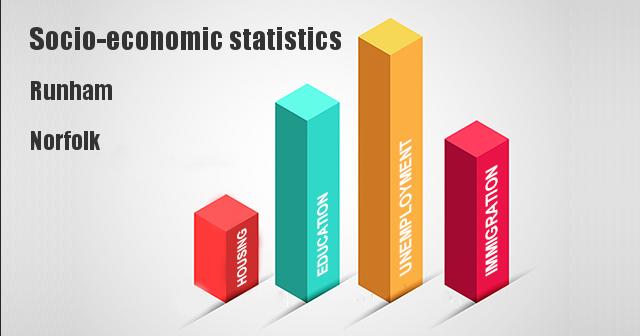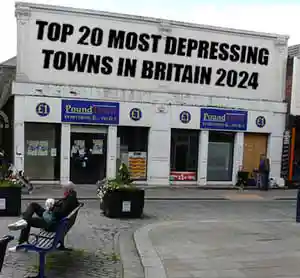Is Runham in Great Yarmouth a nice place to live or is it a bit rough? We have collated a series of socio-economic statistics and demographics from UK government sources such as the 2021 Census and the Index of Multiple Deprivation. They should give you a broad snapshot of the area and the surrounding locations. Are the residents of Runham older than the national average or younger? What is the population of Runham and Great Yarmouth? What is the claimant count in Runham and how many residents are unemployed? This page should provide you with the answers.How many residents own or rent their home in Runham and Great Yarmouth
We have taken the raw data from the 2021 census and calculated what proportion of people in Runham either own or rent their home. All percentages have been rounded to two decimal places. 78.78 of residents own their home either outright or mortgaged. 21.22 of Runham residents rent their home either privately or through a social landlord. | Area | Owned | Rented |
|---|
| Fleggburgh | 78.78% | 21.22% |
| Great Yarmouth | 61.77% | 38.23% |
| East | 65.23% | 34.77% |
| England | 61.31% | 38.69% |
Runham has a significantly higher level of home ownership than the national average. This is indicative or an economically wealthy area.
Runham compared to other wards in Great Yarmouth
| # | Ward | Owned | Rented |
|---|
| 1 | Bradwell North | 83.16% | 16.84% |
|---|
| 2 | Ormesby (Great Yarmouth) | 83.13% | 16.87% |
|---|
| 3 | Lothingland (Great Yarmouth) | 82.27% | 17.73% |
|---|
| 4 | Caister North | 80.93% | 19.07% |
|---|
| 5 | East Flegg | 79.94% | 20.06% |
|---|
| 6 | West Flegg | 79.39% | 20.61% |
|---|
| 7 | Fleggburgh | 78.78% | 21.22% |
|---|
| 8 | Bradwell South and Hopton | 76.99% | 23.01% |
|---|
| 9 | Caister South | 73.18% | 26.82% |
|---|
| 10 | Gorleston | 70.32% | 29.68% |
|---|
| 11 | St Andrews (Great Yarmouth) | 59.57% | 40.43% |
|---|
| 12 | Yarmouth North | 59.36% | 40.64% |
|---|
| 13 | Magdalen | 50.37% | 49.63% |
|---|
| 14 | Claydon | 48.47% | 51.53% |
|---|
| 15 | Southtown and Cobholm | 44.16% | 55.84% |
|---|
| 16 | Central and Northgate | 34.69% | 65.31% |
|---|
| 17 | Nelson (Great Yarmouth) | 25.93% | 74.07% |
|---|
Runham is ranked 7 out of 17 wards in Great Yarmouth for the percentage of home owners.Runham Education Statistics
We have taken the raw data from the 2021 census to found of the level of education Runham residents have in terms of formal qualifications as a percentage. The UK government breaks qualifications down into 7 levels. A detailed explanation of these levels can be found here. However, the Census groups these into just 4 \'levels\'. Here are some examples of the qualifications each census level represents when not stated;
- Level 1 - GCSE grades D, E, F, or G & below
- Level 2 - GCSE A*, A, B, C or O Level grades A, B or C
- Level 3 - A or AS qualification at any grade
- Level 4 - HNC, Bachelors Degree, Masters Degree or Phd
In this first table we have compared Runham to the national average for England.
| Level | Fleggburgh | England |
|---|
| No Qualifications | 17.69% | 18.08% |
| Level 1 | 11.16% | 9.69% |
| Level 2 | 14.67% | 13.32% |
| Apprenticeship | 7.14% | 5.32% |
| Level 3 | 19.13% | 16.92% |
| Level 4 | 27.41% | 33.92% |
Runham Unemployment Statistics
Since the introduction of Universal Credit, The Department for Work & Pensions have not issued any statistics (in our view) that can be used to ascertain the levels of unemployment or under employment in the UK, just meaningless geographic counts. However, the Office of National Statistics does publish claimant counts of people receiving out of work benefits, be that legacy Jobseeker’s Allowance or Universal Credit as a proportion of people over 16. These figures are usually updated once a month and are for Local Authority Districts and Unitary Authority Districts. So below are the figures of Great Yarmouth.| Area | Unemployed | Yearly Change |
|---|
| Great Yarmouth | 5.1% | -0.6% |
| East of England | 3% | -0.3% |
| England | 3.8% | -0.3% |
| UK | 3.7% | -0.3% |
| Economic Status | Proportion |
|---|
| In Employment | 55% |
| In Part-Time Work | 32.79% |
| Unemployed | 3.39% |
Runham & Great Yarmouth Immigration Statistics
We have analysed the Census 2021 raw data on country of birth and compiled immigration statistics as percentages of the population. All percentages have been rounded to two decimal places. Below are the figures for Runham in the Great Yarmouth local area district.
Runham has a lower rate of immigrants than Great Yarmouth, the East of England region and England as a whole. | Area | Born in UK | Born outside UK |
|---|
| Fleggburgh | 95.7% | 4.3% |
|---|
| Great Yarmouth | 90.23% | 9.77% |
|---|
| East | 85.09% | 14.91% |
|---|
| England | 82.65% | 17.35% |
|---|
Runham compared to other wards in Great Yarmouth
| # | Ward | Born in UK | Born outside UK |
|---|
| 1 | Nelson | 71.15% | 28.85% |
|---|
| 2 | Central and Northgate | 77% | 23% |
|---|
| 3 | Southtown and Cobholm | 82.81% | 17.19% |
|---|
| 4 | Gorleston | 89.96% | 10.04% |
|---|
| 5 | Magdalen | 90.77% | 9.23% |
|---|
| 6 | Yarmouth North | 91.12% | 8.88% |
|---|
| 7 | St Andrews | 92.37% | 7.63% |
|---|
| 8 | Claydon | 94.65% | 5.35% |
|---|
| 9 | Caister South | 95.69% | 4.31% |
|---|
| 10 | Fleggburgh | 95.7% | 4.3% |
|---|
| 11 | Bradwell South and Hopton | 95.73% | 4.27% |
|---|
| 12 | Bradwell North | 96.16% | 3.84% |
|---|
| 13 | Ormesby | 96.24% | 3.76% |
|---|
| 14 | Caister North | 96.39% | 3.61% |
|---|
| 15 | East Flegg | 96.77% | 3.23% |
|---|
| 16 | Lothingland | 96.87% | 3.13% |
|---|
| 17 | West Flegg | 97.37% | 2.63% |
|---|
';Runham is ranked 10 out of 17 wards in Great Yarmouth for the number of residents born outside of the UK.What are the occupations of the residents of Runham?
The largest employment sector in Runham is Managers, Directors & Senior Officials. The smallest employment sector is Process Plant & Machine Operatives.| Sector | Proportion |
|---|
| Managers, Directors & Senior Officials | 17.94% |
| Professional Occupations | 17.08% |
| Skilled Trades | 12.71% |
| Administrative & Secretarial | 10.92% |
| Caring, leisure & Other Services | 10.92% |
| Associate Professional & Technical | 10.76% |
| Elementary Occupations | 7.64% |
| Process Plant & Machine Operatives | 6.24% |
Runham Age Distribution Statistics
We have taken the raw data from the 2021 Census and the calculated the proportion of age groups in Fleggburgh.| Age Band | Proportion |
|---|
| 4 & under |  |
| 5 - 9 years |  |
| 10 - 15 years |  |
| 16 - 19 years |  |
| 20 - 24 years |  |
| 25 - 34 years |  |
| 35 - 49 years |  |
| 50 - 64 years |  |
| 65 - 74 years |  |
| 75 - 84 years |  |
| 85 years & over |  |
Runham Health Statistics
Fleggburgh has a lower proportion of residents (very_good_pc-$ward_health->very_good_pc, 2)%) describing their health as very good than the national average for England.| Area | VG | G | F | B | VB |
|---|
| Fleggburgh | 45.47% | 36.65% | 12.83% | 3.93% | 1.11% |
| Great Yarmouth | 40.19% | 35.92% | 16.64% | 5.62% | 1.62% |
| East | 48.28% | 34.64% | 12.5% | 3.58% | 1% |
| England | 48.49% | 33.71% | 12.65% | 3.98% | 1.17% |
VG = Very Good, G = Good, F = Fair, B = Bad & VB = Very Bad
How has the health of residents in Great Yarmouth changed since 2011?
Great Yarmouth residents who describe their health as either good or very good has decreased by 0.2% between the 2011 and 2021 census.| Year | VG | G | F | B | VB |
|---|
| 2011 | 40.3% | 36.01% | 16.58% | 5.48% | 1.63% |
| 2021 | 40.19% | 35.92% | 16.64% | 5.62% | 1.62% |
VG = Very Good, G = Good, F = Fair, B = Bad & VB = Very Bad
What is the population of Runham and Great Yarmouth?
The table below contains the populations figures for each ward in Great Yarmouth including Runham. These population ONS figures are estimated are dated Mid 2020.
| Ward | Population |
|---|
| Bradwell North | 6355 |
| Bradwell South and Hopton | 7307 |
| Caister North | 4382 |
| Caister South | 4592 |
| Central and Northgate | 8853 |
| Claydon | 7605 |
| East Flegg | 4809 |
| Fleggburgh | 2525 |
| Gorleston | 5249 |
| Lothingland | 5222 |
| Magdalen | 7530 |
| Nelson | 9608 |
| Ormesby | 4313 |
| Southtown and Cobholm | 5931 |
| St Andrews | 5304 |
| West Flegg | 5039 |
| Yarmouth North | 4574 |
| Great Yarmouth Total | 99198 |
Last updated: 20/02/2024, Additional Sources: Office for National Statistics & Department for Work & Pensions.














